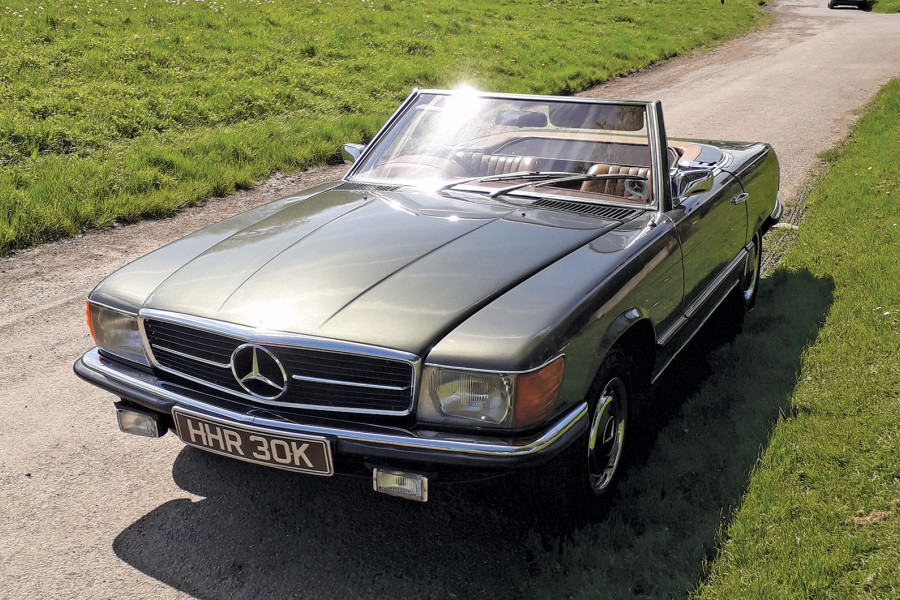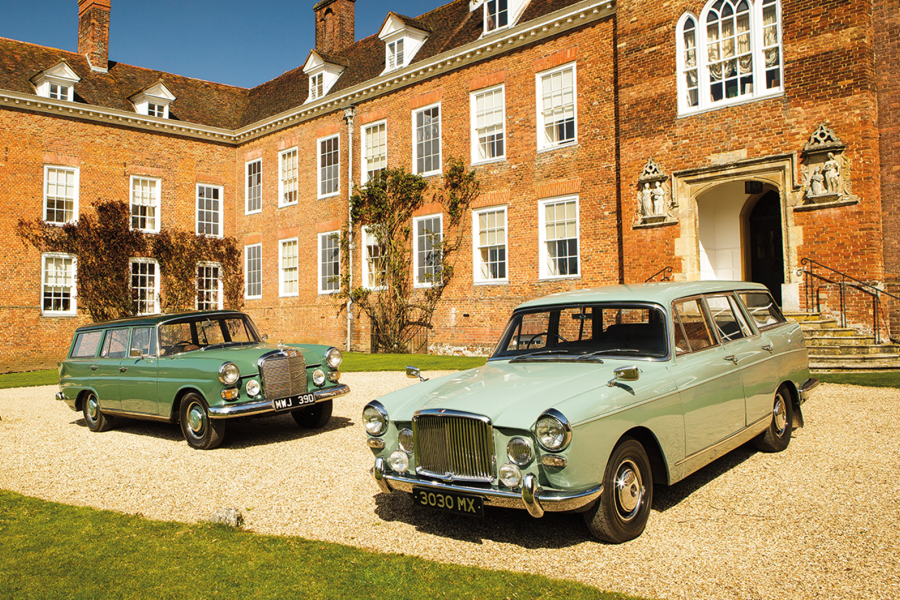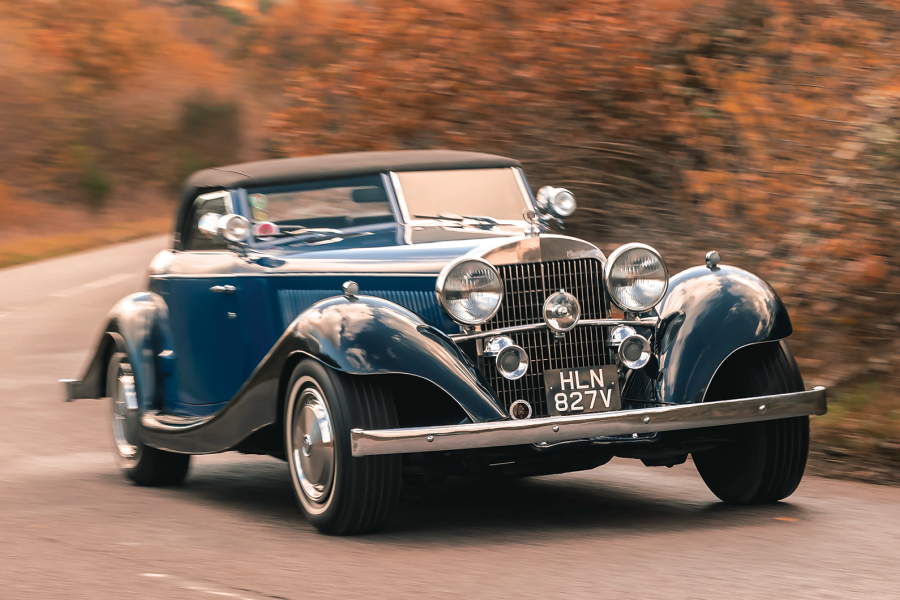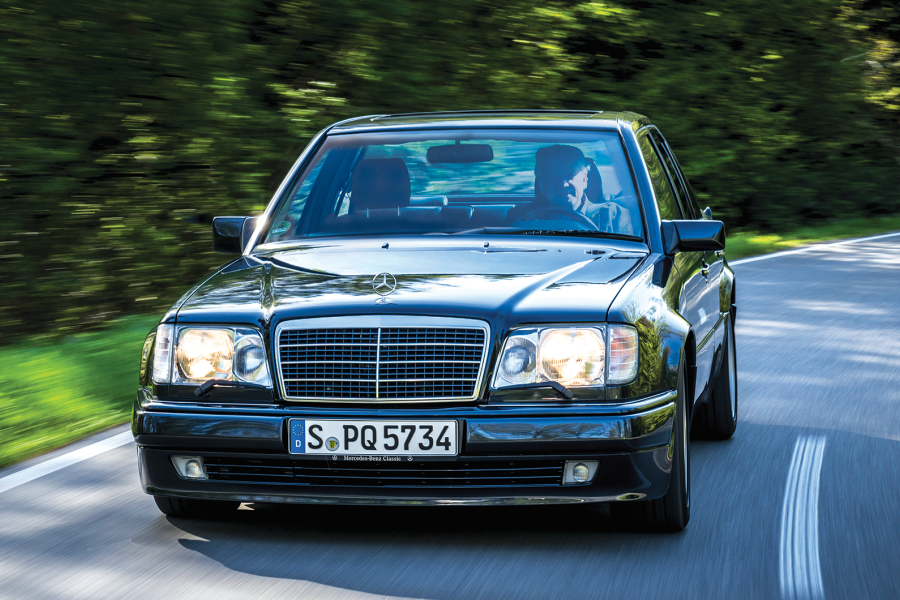Even the keyholes in the Seville’s doors were illuminated at night, and if you invested in an Elegante model – such as this one, property of collector Fredrik Folkestad – you got the dubious benefit of a two-tone paint finish, fake alloy wheels and a wreathed Cadillac emblem atop that chromed radiator grille.
Fredrik’s car, recently imported from Sweden, has the optional ‘Touring’ suspension offered to customers who wanted a more European feel to the ride and handling.
The Mercedes’ handsome yet understated profile is timeless
Inside, the brown MB-Tex used throughout the 300D makes it feel as austerely practical as the buttoned leather of the Cadillac’s twin sofas is regal.
Electric windows all round give the German car a hint of luxury, but the Cadillac’s roomier interior, with its flat front floor, is of a completely different, chintzier sensibility.
Yet it is undeniably welcoming and comfortable: a place where, beyond the fake wood and chrome details, the boxy architecture of the dashboard is clear and logical.
Yes, its skinny ribbon speedometer was an anachronism by the early ’80s, ditto the column gear selector for the three-speed automatic gearbox, but that was how Cadillac customers wanted it.
Electric windows are among the few concessions to luxury in the Mercedes-Benz 300D
The 300D’s engine, with its polished cam cover, appears less utilitarian than most Benz diesels, whereas the Cadillac powerplant looks as industrial as any other American V8.
On start-up, both are relatively knock-free, but cannot disguise their oil-burning origins. Under way, the Cadillac is by far the more refined of the two, with only a slight vibration to let you know it is running and no great indication (with bonnet shut and frameless doors closed) you are driving a diesel.
This almost distracts you from the tragic lack of acceleration.
Gearchanges are imperceptible, but using kickdown only serves to make the engine rumble slightly more loudly rather than urge the car forward any faster.
Fitted with air-con, this Mercedes 300D was primed for a life spent travelling in hot conditions
On paper, the 300D doesn’t do much better in a straight line.
Yet, even as an auto, acceleration in the Benz borders on the semi-brisk, and it gathers speed in a fairly fuss-free way that is far removed from the usual derv W123 experience.
The four-speed automatic was strengthened to take the diesel’s torque and is recalibrated to pull away in first gear rather than second, although to avoid ‘creep’ it holds itself in second at standstill until the throttle is squeezed.
The handling and ride are probably what make this 300D so different to most other 123 saloons.
Its heavy-duty springs with self-levelling mean that it sits around 1½in higher than a normal 300D, and gives an exceptionally smooth and compliant ride, regardless of the load or the number of passengers. Aviv confirms it takes London speed bumps beautifully.
The Mercedes 300D has a spacious rear bench
That said, I suspect the Seville would be its equal in terms of smoothing road-surface irregularities – and rather better at smothering road noise.
The Cadillac is a quiet car even by modern standards, with few rattles.
It is hard to be definitive about ‘build quality’, but the fit and finish of the Seville don’t look far behind the Mercedes, at least superficially.
Neither is the handling. Yes, the steering is lighter than the surefooted 300D, but it has some feel and is reasonably responsive.
With its front-drive and relatively modest levels of lean and wallow, the Cadillac corners faithfully and reassuringly, but with a more detached and expensive feel than the Mercedes.
Heavy-duty springs were added to this Mercedes 300D in preparation for the armour-plating that was never fitted
With almost 200,000 built through to 1986, the Seville was a commercial success but a reputational failure, perhaps the most ‘malaise’ of all Cadillacs – if you acknowledge that the dreadful Cimarron was just a tarted-up Chevy.
It certainly didn’t measure up to the ‘standard of the world’ mission statement that had underpinned the marque for decades.
That title had long since gravitated to the Germans, and to Mercedes-Benz.
The US industry had squandered decades on a formula of annual sheet-metal restyles garnished with crowd-pleasing luxury features.
The Mercedes 300D bolstered the German marque’s reputation for reliability
In contrast, the 300D was the product of a firm that had laboured away stoically at safe, highly drivable and far more durable-than-average vehicles to a straightforward recipe that made concerns about marketing and famously high prices entirely subordinate to engineering excellence.
If Cadillac built what it thought you wanted, Mercedes built the car it knew you needed, leading customer taste rather than pandering to it. You either got it or you didn’t.
In North America, an increasing number of buyers did, and when thoughts turned to the idea of a diesel luxury car, no maker was in a better position to lead the way.
‘The Mercedes gives an exceptionally smooth and compliant ride, regardless of the load or the number of passengers on board’
Though not exciting, the 300D was possibly the first diesel you might have bought out of choice, rather than necessity.
Maybe, with a blanket 55mph speed limit, the sheer sloth of the Seville didn’t matter that much on home turf.
Possibly, but the reliability problems most certainly did.
It’s a better car than it looks – which perhaps isn’t saying much – but with a prettier body and a decent petrol V8, it could almost be desirable.
Images: John Bradshaw
Factfiles
Cadillac Seville
- Sold/number built 1979-’86/198,155 (all)
- Construction steel perimeter-frame chassis, steel body
- Engine all-iron, ohv 5737cc diesel V8, fuel injection
- Max power 105bhp @ 3200rpm
- Max torque 205Ib ft @ 1600rpm
- Transmission three-speed auto, FWD
- Suspension independent, at front by wishbones, torsion bars, telescopic dampers rear trailing arms, air springs; anti-roll bar f/r
- Steering power-assisted recirculating ball
- Brakes discs, with servo
- Length 17ft (5202mm)
- Width 5ft 9in (1801mm)
- Height 4ft 5in (1379mm)
- Wheelbase 9ft 5in (2896mm)
- Weight 4184Ib (1898kg)
- Mpg 20-24
- 0-60mph 19.7 secs
- Top speed 83mph
- Price new $20,400
- Price now £6-10,000*
Mercedes-Benz 300D
- Sold/number built 1976-’84/324,718
- Construction steel unitary
- Engine iron-block, alloy-head, sohc 3005cc diesel ‘five’, fuel injection
- Max power 87bhp @ 4400rpm
- Max torque 127Ib ft @ 2400rpm
- Transmission four-speed automatic, RWD
- Suspension independent, at front by wishbones rear semi-trailing arms, self-levelling; coil springs, telescopic dampers, anti-roll bar f/r
- Steering power-assisted recirculating ball
- Brakes discs, with servo
- Length 15ft 5in (4725mm)
- Width 5ft 8in (1786mm)
- Height 4ft 7in (1438mm)
- Wheelbase 9ft 1in (2795mm)
- Weight 3186Ib (1445kg)
- Mpg 24-28
- 0-60mph 17.7 secs
- Top speed 96mph
- Price new £11,146
- Price now £10-30,000*
*Prices correct at date of original publication
Enjoy more of the world’s best classic car content every month when you subscribe to C&SC – get our latest deals here
READ MORE
27 diesel-powered classic cars
Mercedes-Benz W116 S-Class: the best car in the world?
Rolls-Royce Silver Cloud III vs Cadillac Series 62: the sky is the limit
Martin Buckley
Senior Contributor, Classic & Sports Car



























